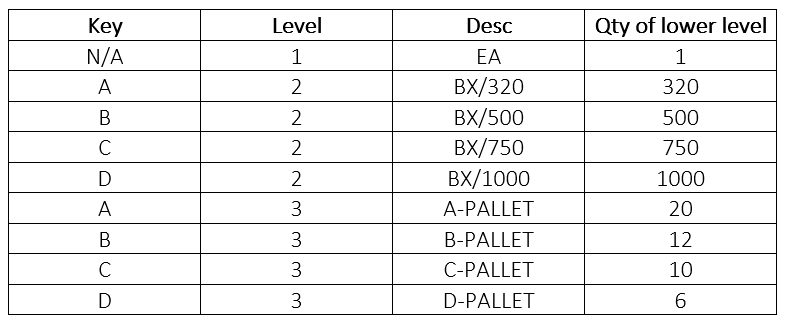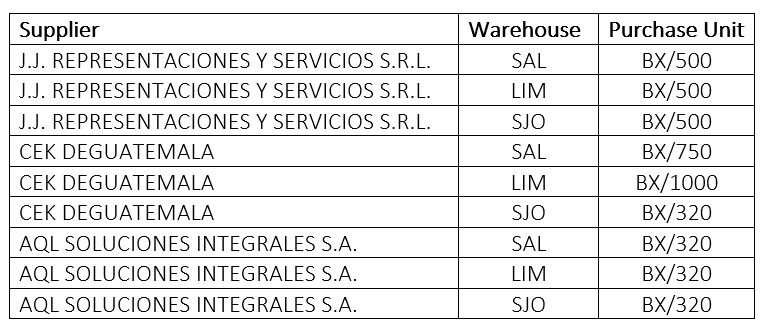Difference between revisions of "StockItem ItemPacksIndex"
(Updated to use Tips and tricks template, swapped HTML header tags for wikitext headers, added comment to Page Author about using tables instead of images) |
|||
| Line 1: | Line 1: | ||
| − | + | <!-- Note to Page Author: Please update the tables to use real tables instead of images, see https://www.mediawiki.org/wiki/Help:Tables --> | |
| − | + | {{Tips and tricks}} | |
__TOC__ | __TOC__ | ||
| − | + | =Stock Item Packs= | |
| − | + | ==Item Level== | |
| − | |||
Firstly at Item Level you must define all the possible pack sizes against the item below, see example for Napkins, this comes/has come in 4 different pack sizes 320, 500, 750 or 1,000. In such a case the Stocking unit must be EA (Eaches) then we will have 5 Packs under this as below; | Firstly at Item Level you must define all the possible pack sizes against the item below, see example for Napkins, this comes/has come in 4 different pack sizes 320, 500, 750 or 1,000. In such a case the Stocking unit must be EA (Eaches) then we will have 5 Packs under this as below; | ||
| Line 25: | Line 24: | ||
When the above table is created in SkyLog you must identify one of the above structures as a default for issue but this is only used if there is no default at the Station Level see below. | When the above table is created in SkyLog you must identify one of the above structures as a default for issue but this is only used if there is no default at the Station Level see below. | ||
| − | + | ==Issuing out== | |
| − | |||
| − | |||
It is possible in SkyLog to define a default issue pack size for each station/Item and also you define which stations are supplied by which stations. | It is possible in SkyLog to define a default issue pack size for each station/Item and also you define which stations are supplied by which stations. | ||
| − | + | ===Example=== | |
| − | |||
If you have Coke that is supplied to LIM in Boxes of 24 and supplied to SAL in Boxes of 12 then you would set the default unit of issue for all the LIM supplied stations to 24 and for all the SAL supplied stations to 12. Although you would have also a default at Item level (see above) this will only be used if there is no default at the Station level. What then happens is any suggested quantity is rounded to the multiples of 24 for the LIM stations but to quantities of 12 for the SAL stations thus avoiding having the warehouse have to open boxes or manually round the quantities on their end. | If you have Coke that is supplied to LIM in Boxes of 24 and supplied to SAL in Boxes of 12 then you would set the default unit of issue for all the LIM supplied stations to 24 and for all the SAL supplied stations to 12. Although you would have also a default at Item level (see above) this will only be used if there is no default at the Station level. What then happens is any suggested quantity is rounded to the multiples of 24 for the LIM stations but to quantities of 12 for the SAL stations thus avoiding having the warehouse have to open boxes or manually round the quantities on their end. | ||
Now lets consider an example where there is mixed pack sizes in one warehouse because say you changed supplier. In this case you would have to leave all or some stations to use the old pack size until the inventory was depleted then switch over the default once all the old stock was burned off. The only other alternative would be to repack the old inventory to the new pack size. | Now lets consider an example where there is mixed pack sizes in one warehouse because say you changed supplier. In this case you would have to leave all or some stations to use the old pack size until the inventory was depleted then switch over the default once all the old stock was burned off. The only other alternative would be to repack the old inventory to the new pack size. | ||
| − | + | ==Purchasing== | |
| − | |||
For each supplier of an item you can specify a different purchasing unit per warehouse so in the case of the Napkins where we could have | For each supplier of an item you can specify a different purchasing unit per warehouse so in the case of the Napkins where we could have | ||
| Line 46: | Line 41: | ||
Note that it is not possible have a mixture of Purchasing units defined for the same supplier/warehouse combination so if you have the situation where CEK DE Guatemala supplies in boxes of 1000 and 750 to SAL we need to stop that. | Note that it is not possible have a mixture of Purchasing units defined for the same supplier/warehouse combination so if you have the situation where CEK DE Guatemala supplies in boxes of 1000 and 750 to SAL we need to stop that. | ||
| − | + | ==Consequences/Actions== | |
| − | |||
1. For those items where the pack quantities are so varied the Stocking Unit in Oracle must be Eaches it cannot be a Box | 1. For those items where the pack quantities are so varied the Stocking Unit in Oracle must be Eaches it cannot be a Box | ||
2. In the warehouse there should be a chart/paper on the location that explains the conversion form eaches to the box in order to eliminate the warehouse picking too much (i.e. assuming the qty is in boxes when in fact it is eaches). They will need to make a manual calculation ito convert. This step can be eliminate when proper units are implemented in Oracle because then SkyLog can send the quantities in the correct unit of issue rather than eaches. | 2. In the warehouse there should be a chart/paper on the location that explains the conversion form eaches to the box in order to eliminate the warehouse picking too much (i.e. assuming the qty is in boxes when in fact it is eaches). They will need to make a manual calculation ito convert. This step can be eliminate when proper units are implemented in Oracle because then SkyLog can send the quantities in the correct unit of issue rather than eaches. | ||
3. We need to go back to those suppliers that are shipping to the same warehosu ein different pack sizes and enforce a consisitency | 3. We need to go back to those suppliers that are shipping to the same warehosu ein different pack sizes and enforce a consisitency | ||
Revision as of 14:41, 21 September 2021
Please use our Tips and Tricks page for understanding how the SkySuite portal works and how to navigate faster and easier.
Contents
Stock Item Packs
Item Level
Firstly at Item Level you must define all the possible pack sizes against the item below, see example for Napkins, this comes/has come in 4 different pack sizes 320, 500, 750 or 1,000. In such a case the Stocking unit must be EA (Eaches) then we will have 5 Packs under this as below;
Let’s make this a bit more complicated and say we have Pallet Configurations also defined and there are;
20 BX/320’s on a Pallet 12 BX/500’s on a Pallet 10 BX/750’s on a Pallet 6 BX/1000’s on a Pallet
Then this would be created as;
When the above table is created in SkyLog you must identify one of the above structures as a default for issue but this is only used if there is no default at the Station Level see below.
Issuing out
It is possible in SkyLog to define a default issue pack size for each station/Item and also you define which stations are supplied by which stations.
Example
If you have Coke that is supplied to LIM in Boxes of 24 and supplied to SAL in Boxes of 12 then you would set the default unit of issue for all the LIM supplied stations to 24 and for all the SAL supplied stations to 12. Although you would have also a default at Item level (see above) this will only be used if there is no default at the Station level. What then happens is any suggested quantity is rounded to the multiples of 24 for the LIM stations but to quantities of 12 for the SAL stations thus avoiding having the warehouse have to open boxes or manually round the quantities on their end.
Now lets consider an example where there is mixed pack sizes in one warehouse because say you changed supplier. In this case you would have to leave all or some stations to use the old pack size until the inventory was depleted then switch over the default once all the old stock was burned off. The only other alternative would be to repack the old inventory to the new pack size.
Purchasing
For each supplier of an item you can specify a different purchasing unit per warehouse so in the case of the Napkins where we could have
In the above example all PO’s for J.J. REPRESENTACIONES Y SERVICIOS S.R.L. would be rounded to 500 while all PO’s for AQL SOLUCIONES INTEGRALES S.A. would be rounded to 320 and PO’s for CEK DE GUATEMALA would be rounded to either 320, 750 or 1000 depending on what Warehouse they were for.
Note that it is not possible have a mixture of Purchasing units defined for the same supplier/warehouse combination so if you have the situation where CEK DE Guatemala supplies in boxes of 1000 and 750 to SAL we need to stop that.
Consequences/Actions
1. For those items where the pack quantities are so varied the Stocking Unit in Oracle must be Eaches it cannot be a Box 2. In the warehouse there should be a chart/paper on the location that explains the conversion form eaches to the box in order to eliminate the warehouse picking too much (i.e. assuming the qty is in boxes when in fact it is eaches). They will need to make a manual calculation ito convert. This step can be eliminate when proper units are implemented in Oracle because then SkyLog can send the quantities in the correct unit of issue rather than eaches. 3. We need to go back to those suppliers that are shipping to the same warehosu ein different pack sizes and enforce a consisitency


